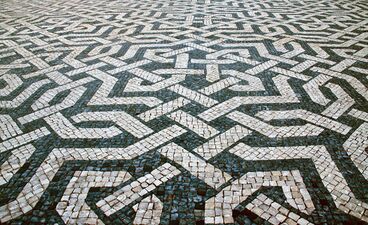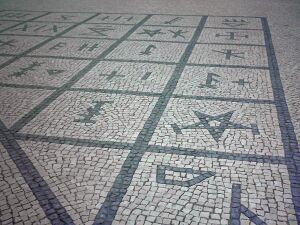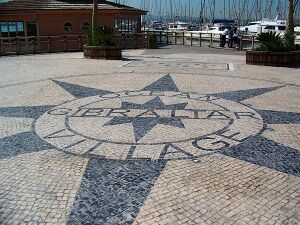Engineering:Portuguese pavement

Portuguese pavement, known in Portuguese as calçada portuguesa or simply calçada (or pedra portuguesa in Brazil) is a traditional-style pavement used for many pedestrian areas in Portugal. It consists of small flat pieces of stones arranged in a pattern or image, like a mosaic. It can also be found in Olivença (a disputed territory administered by Spain) and throughout former Portuguese colonies, especially in Brazil . Portuguese workers are also hired for their skill in creating these pavements in places such as Gibraltar. Being usually used in sidewalks, it is in town squares and atriums that this art finds its deepest expression.
One of the most distinctive uses of this paving technique is the image of Saint-Queen Elizabeth of Portugal (Santa Rainha Isabel), in Coimbra, designed with black and white stones of basalt and limestone.
History

- irregular pavements, thought to be the oldest style
- crushed pavement, similar but with more spaces between the stones
- classic style, with one primary diagonal and one secondary, both at 45 degrees to the adjoining kerb and/or wall.
- linear pavement, with stones aligned in parallel files
- circular pavement
- hexagonal pavement
- artistic pavement, with specific forms and/or highly contrasting stones
- large wavy pattern
- segmented fans
- florentine fans
- peacock tails
- less regular peacock tails
Paving as a craft is believed to have originated in Mesopotamia, where rocky materials were used in the inside and outside of constructions, being later brought to Ancient Greece and Ancient Rome.
The Romans used to pave the vias connecting the empire using materials to be found in the surroundings. Some of the Roman techniques introduced then are still applied on the calçada, most noticeably the use of a foundation and a surfacing.
In its current form, Portuguese pavement was first used in Lisbon from 1840 to 1846, during repairs to São Jorge Castle directed by general and engineer Eusebio Pinheiro Furtado.[2] These included the repvament of the castle's courtyards with a zigzag pattern of alternating black and white stones deemed atypical for the time.
In 1848, Pinheiro was put in charge with the renewal of Rossio square, which he paved with a pattern of waves in homage to the sea crossed by Portuguese sailors. From then onward, the calçada began to spread throughout the streets of Lisbon and Portugal as a whole. Much of the motifs and patterns would revolve around the sea and maritime exploration, and the pavement quickly became a symbol of Portuguese culture and identity, also spreading overseas to Portugal's colonies.[2]
Portuguese pavement spread to Spain in the late 19th century, most notably to Barcelona in 1896, where it was used to pave the sides of the Salón de San Juan, with later expansions in 1909 and 1947-1920.[3]
It was not until 1905 when Portuguese pavement was first used in Brazil, in the city of Manaus. Belo Horizonte followed suit, and then Rio de Janeiro. In Rio, mayor Francisco Pereira Passos was a strong promoter of implementing the calçada as part of the city's urban renewal plan, which was subsequently adopted in the reworking of Avenida Rio Branco, importing calceteiros, designs and even stones from Portugal. The remaining building materials were destined to the newly innaugurated Avenida Atlântica, in its iconic wavy pattern. Portuguese pavement then began to plofirate through Rio. Unlike in Portugal -where stone colours are limited to black and white-, red, yellow, and grey are also employed in Brazil.[2]
In the 1940s, the Portuguese calçada began to evolve in line with the principles of the International Style, developing abstract geometric patterns. In Brazil, this pavement was used in many projects directed by modernist achritects, in which they blended traditional materials and techniques like the calçada with contemporary design. Roberto Burle Marx applied it to many of his works and conserved it when redesigning Copacabana in the 1970s.[2]
Future
This book may need to be updated to reflect current knowledge. |
Very little new paving of this type is done, and the entire profession is at risk. The long hours and low wages typical of calceteiros have reduced apprenticeships and thus new pavers. Furthermore, as the pavement is less safe (provides less traction when wet; loose stones can become tripping hazards), costs more (especially with the difficulty of obtaining appropriate stones), and wears quicker than concrete or asphalt, there is also dropping interest in investment and construction in it. Although there were once hundreds of calceteiros, most modern work is on conservation or major architectural projects.[citation needed]
In spite of its historical and cultural value, this type of pavement has raised concerns in recent times, particularly in regards to its accessibility. Portuguese pavement has been noted for being particularly slippery, a condition worsened by natural wear and tear as well as by rainy conditions, the latter of which also allows for the formation of puddles in more concave, worn-out sections. Other disadvantages include the propensity for weeds and moss to form in its cracks.[4] The loosening of stones is also a relevant issue, making sidewalks covered by this type of pavement need constant maintenance and repair in order to avoid pedestrians from tripping. These qualities have often made transport for the elderly, wheelchair users, pregnant women and babies in strollers particularly difficult. Portuguese pavement is also especially harsh on some types of footwear.[5]
In Portugal, Porto completely replaced the traditional pavement of its city centre for granite blocks in 2005.[5]
In Brazil, while São Paulo has almost completely replaced the Portuguese pavement sidewalks of Paulista Avenue with a cheaper, more regular type of concrete pavement since 2007,[5] other cities such as Rio de Janeiro still have nearly ubiquitous Portuguese pavement, particularly in more affluent areas.
It can also be found around the Asunción Super Centro building in Asunción, Paraguay.[6]
Technique
Craftsmen lay a bedding of gravel upon a well-compacted trench of argillaceous materials, which accommodates the tessera stones, acting as a cement.
Calçada as a form of art
Stars in Lisbon
The Senado Square's distinctive tiled pattern in Macau
Compass rose depicted in São Jorge, Azores
Portuguese pavement near Pavilhão Atlântico at Parque das Nações, Lisbon, Portugal
Portuguese pavement in Alameda Manuel Van Dunen, Luanda, Angola
Portuguese pavement in Generoso Marques Square, Curitiba, Brazil
Portuguese Centennial Park, Hayward, United States
Pavement on the Rossio Square (Praça do Rossio), Lisbon
A transistor symbol at the University of Aveiro
See also
- Sett (paving)
- Mosaic
- Terrazzo
- Engineered stone
References
- ↑ Prof. Ricardo Cunha Teixeira. Artigo no jornal Tribuna das Ilhas, "A matemática dos antigos". 20 September 2023. http://www.tribunadasilhas.pt/index.php/opiniao/item/7625-a-matem/.
- ↑ 2.0 2.1 2.2 2.3 Rey Pérez, Julia. "La construcción del espacio público con piedra portuguesa: el pavimento como soporte de cultura y sostenibilidad" (in es). ASRI Arte y sociedad (8). ISSN 2174-7563. https://dialnet.unirioja.es/servlet/articulo?codigo=5029083. Retrieved 27 January 2024.
- ↑ Remesar, Antoni; Esparza Lozano, Dánae. "El diseño del suelo y la imagen de la ciudad: La calçada portuguesa" (in es). On the W@terfront (32): 9-15. ISSN 1139-7365. https://dialnet.unirioja.es/servlet/articulo?codigo=6899913. Retrieved 27 January 2024.
- ↑ Medeiros Veiga, Marcia Regina (2020) (in Portuguese). Territórios de Cuidado: Protagonismo e pluralidade na velhice. Coimbra: Coimbra University Press. p. 67-68. ISBN 9789892617978. https://books.google.com/books?id=5nrrDwAAQBAJ.
- ↑ 5.0 5.1 5.2 Cambiaghi, Silvana (December 2017). "Calçada em pedra portuguesa é adequada para utilização por todas as pessoas?" (in Portuguese). Móbile (São Paulo: Revista CAU/SP): 20-21. ISSN 2448-3885. https://issuu.com/causp_oficial/docs/m__bile__11_jan2018. Retrieved 2024-01-12.
- ↑ "Asunción Super Centro". https://foursquare.com/v/asunci%C3%B3n-super-centro/4dbed9a1432d6a71bf707fbd.
External links
- Paving in Portuguese, urbanphoto.net
- Portuguese pavement and its histories (Portuguese language)
- The Portuguese Pavements Handbook (10 MB), Direccção Nacional de Energia e Geologia (Portuguese/English)
 |




























